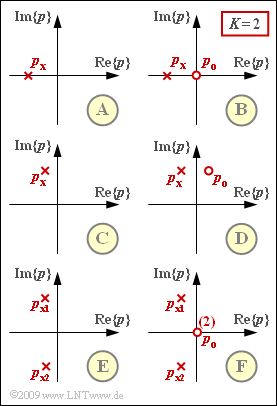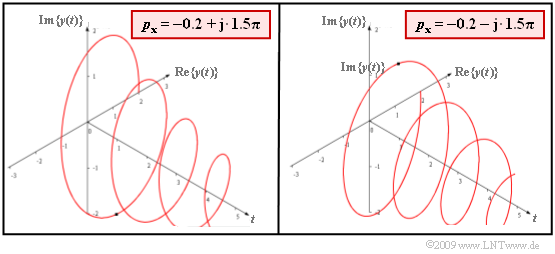Aufgaben:Aufgabe 3.5Z: Anwendung des Residuensatzes: Unterschied zwischen den Versionen
| Zeile 62: | Zeile 62: | ||
===Musterlösung=== | ===Musterlösung=== | ||
{{ML-Kopf}} | {{ML-Kopf}} | ||
| − | + | '''(1)''' Voraussetzung für die Anwendung des Residuensatzes ist, dass es weniger Nullstellen als Pole gibt, das heißt, es muss $Z < N$ gelten. Diese Voraussetzung ist <u>bei den Konfigurationen <b>B</b>, <b>D</b> und <b>F</b> nicht gegeben</u>. Hier muss zunächst eine Partialbruchzerlegung vorgenommen werden, zum Beispiel für die Konfiguration <b>B</b> mit $p_x = -1$: | |
| − | + | $$Y_{\rm L}(p)= \frac {p} {p +1}= 1-\frac {1} {p +1} | |
\hspace{0.05cm} .$$ | \hspace{0.05cm} .$$ | ||
| − | + | ||
| − | + | '''(2)''' Mit $Y_{\rm L}(p) = 2/(p+1)$ ergibt sich aus dem Residuensatz mit $I=1$: | |
| + | $$y(t) = 2 \cdot {\rm e}^{\hspace{0.05cm}p \hspace{0.05cm}t} | ||
\bigg |_{p \hspace{0.05cm}= \hspace{0.05cm}-1}= 2 \cdot {\rm | \bigg |_{p \hspace{0.05cm}= \hspace{0.05cm}-1}= 2 \cdot {\rm | ||
e}^{- \hspace{0.05cm}t}\hspace{0.3cm}\Rightarrow \hspace{0.3cm}y(t=1) | e}^{- \hspace{0.05cm}t}\hspace{0.3cm}\Rightarrow \hspace{0.3cm}y(t=1) | ||
| Zeile 73: | Zeile 74: | ||
\hspace{0.05cm} .$$ | \hspace{0.05cm} .$$ | ||
| − | + | ||
| − | + | '''(3)''' Bei gleicher Vorgehensweise wie in der Teilaufgabe (2) erhält man nun: | |
| + | $$y(t) = 2 \cdot {\rm e}^{\hspace{0.05cm}-(0.2 \hspace{0.05cm}+ | ||
\hspace{0.05cm}{\rm j} \hspace{0.05cm}\cdot \hspace{0.05cm}1.5 \pi) \hspace{0.05cm} \cdot \hspace{0.05cm}t} | \hspace{0.05cm}{\rm j} \hspace{0.05cm}\cdot \hspace{0.05cm}1.5 \pi) \hspace{0.05cm} \cdot \hspace{0.05cm}t} | ||
= 2 \cdot {\rm e}^{\hspace{0.05cm}-0.2 \hspace{0.08cm}\cdot | = 2 \cdot {\rm e}^{\hspace{0.05cm}-0.2 \hspace{0.08cm}\cdot | ||
| Zeile 81: | Zeile 83: | ||
\hspace{0.05cm}t} | \hspace{0.05cm}t} | ||
\hspace{0.05cm} .$$ | \hspace{0.05cm} .$$ | ||
| − | + | Aufgrund des zweiten Terms handelt es sich um ein komplexes Signal, dessen Phase in mathematisch positiver Richtung (entgegen dem Uhrzeigersinn) dreht. Für $t=1$ gilt: | |
| − | + | $$y(t = 1) = 2 \cdot {\rm e}^{\hspace{0.05cm}-0.2} \cdot \left [ | |
\cos(1.5 \pi) + {\rm j} \cdot \sin(1.5 \pi) | \cos(1.5 \pi) + {\rm j} \cdot \sin(1.5 \pi) | ||
\right ]= - {\rm j} \cdot 1.638$$ | \right ]= - {\rm j} \cdot 1.638$$ | ||
| − | + | $$\Rightarrow | |
\hspace{0.3cm}{\rm Re}\{y(t = 1)\} \hspace{0.15cm}\underline{ = 0},\hspace{0.2cm} {\rm Im}\{y(t = 1)\} \hspace{0.15cm}\underline{=- 1.638} | \hspace{0.3cm}{\rm Re}\{y(t = 1)\} \hspace{0.15cm}\underline{ = 0},\hspace{0.2cm} {\rm Im}\{y(t = 1)\} \hspace{0.15cm}\underline{=- 1.638} | ||
\hspace{0.05cm} .$$ | \hspace{0.05cm} .$$ | ||
| − | + | Die linke Grafik zeigt das komplexe Signal für einen Pol bei $p_x = -2 + {\rm j} \cdot 1.5 \pi$ . Rechts daneben sieht man das dazu konjugiert–komplexe Signal, wenn der Pol bei $p_x = -2 - {\rm j} \cdot 1.5 \pi$. | |
| − | [[Datei:P_ID1782__LZI_Z_3_5_c.png| | + | |
| − | + | [[Datei:P_ID1782__LZI_Z_3_5_c.png||Komplexe Signale bei einem Pol]] | |
| − | + | ||
| + | |||
| + | '''(4)''' Nun gilt $I=2$. Die Residien von $p_{x1}$ bzw. $p_{x2}$ liefern: | ||
| + | $$y_1(t) = | ||
\frac {K \cdot (p-p_{{\rm x}1})} { (p-p_{{\rm x}1})(p-p_{{\rm x}2})} \cdot {\rm e}^{\hspace{0.05cm}p | \frac {K \cdot (p-p_{{\rm x}1})} { (p-p_{{\rm x}1})(p-p_{{\rm x}2})} \cdot {\rm e}^{\hspace{0.05cm}p | ||
\hspace{0.05cm}t} | \hspace{0.05cm}t} | ||
| Zeile 97: | Zeile 102: | ||
\frac {K } { p_{{\rm x}1}-p_{{\rm x}2}} \cdot {\rm e}^{\hspace{0.05cm}p_{{\rm x}1} | \frac {K } { p_{{\rm x}1}-p_{{\rm x}2}} \cdot {\rm e}^{\hspace{0.05cm}p_{{\rm x}1} | ||
\hspace{0.05cm}t} | \hspace{0.05cm}t} | ||
| − | \hspace{0.05cm} , | + | \hspace{0.05cm} ,$$ |
| − | + | $$ y_2(t) = | |
\frac {K } { p_{{\rm x}2}-p_{{\rm x}1}} \cdot {\rm e}^{\hspace{0.05cm}p_{{\rm x}2} | \frac {K } { p_{{\rm x}2}-p_{{\rm x}1}} \cdot {\rm e}^{\hspace{0.05cm}p_{{\rm x}2} | ||
\hspace{0.05cm}t}= | \hspace{0.05cm}t}= | ||
-\frac {K } { p_{{\rm x}1}-p_{{\rm x}2}} \cdot {\rm e}^{-p_{{\rm x}1} | -\frac {K } { p_{{\rm x}1}-p_{{\rm x}2}} \cdot {\rm e}^{-p_{{\rm x}1} | ||
\hspace{0.05cm}t}$$ | \hspace{0.05cm}t}$$ | ||
| − | + | $$\Rightarrow | |
| − | \hspace{0.3cm}y(t) | + | \hspace{0.3cm}y(t)= y_1(t)+y_2(t) = |
\frac {2 \cdot {\rm e}^{\hspace{0.05cm}-0.2 | \frac {2 \cdot {\rm e}^{\hspace{0.05cm}-0.2 | ||
\hspace{0.08cm}\cdot | \hspace{0.08cm}\cdot | ||
\hspace{0.05cm}t}}{{\rm j} \cdot 3 \pi} \cdot \left [ \cos(.) + {\rm j} \cdot \sin(.) | \hspace{0.05cm}t}}{{\rm j} \cdot 3 \pi} \cdot \left [ \cos(.) + {\rm j} \cdot \sin(.) | ||
| − | - \cos(.) + {\rm j} \cdot \sin(.)\right ]= | + | - \cos(.) + {\rm j} \cdot \sin(.)\right ]= |
| − | |||
\frac {4 }{ 3 \pi} \cdot {\rm e}^{\hspace{0.05cm}-0.2 | \frac {4 }{ 3 \pi} \cdot {\rm e}^{\hspace{0.05cm}-0.2 | ||
\hspace{0.08cm}\cdot | \hspace{0.08cm}\cdot | ||
| − | \hspace{0.05cm}t}\cdot \sin(1.5\pi \cdot t) | + | \hspace{0.05cm}t}\cdot \sin(1.5\pi \cdot t)$$ |
| − | + | ||
| + | [[Datei:P_ID1783__LZI_Z_3_5_d.png|right|Signalverlauf der Konfiguration '''E''']] | ||
| + | $$\Rightarrow | ||
| + | \hspace{0.3cm}y(t=1)= -\frac {4 }{ 3 \pi} \cdot {\rm e}^{\hspace{0.05cm}-0.2 | ||
\hspace{0.08cm}\cdot | \hspace{0.08cm}\cdot | ||
\hspace{0.05cm}t} \hspace{0.15cm}\underline{= -0.347} | \hspace{0.05cm}t} \hspace{0.15cm}\underline{= -0.347} | ||
\hspace{0.05cm} .$$ | \hspace{0.05cm} .$$ | ||
| − | + | ||
| − | + | Die Grafik zeigt den (rein reellen) Signalverlauf $y(t)$ für die Konfiguration <b>E</b>. | |
| + | |||
{{ML-Fuß}} | {{ML-Fuß}} | ||
Version vom 13. Februar 2017, 09:41 Uhr
Die Spektralfunktion $Y_{\rm L}(p)$ sei in Pol–Nullstellen–Form gegeben, gekennzeichnet durch
- $Z$ Nullstellen $p_{{\rm o}i}$,
- $N$> Pole $p_{{\rm x}i}$, sowie
- die Konstante $K$.
Betrachtet werden in dieser Aufgabe die in der Grafik dargestellten Konfigurationen, wobei stets $K= 2$ gilt.
Für den Fall, dass die Anzahl $Z$ der Nullstellen kleiner als die Anzahl $N$ der Pole ist, kann das zugehörige Zeitsignal $y(t)$ durch Anwendung des Residuensatzes direkt ermittelt werden. In diesem Fall gilt $$y(t) = \sum_{i=1}^{I} \left \{ Y_{\rm L}(p)\cdot (p - p_{{\rm x}i})\cdot {\rm e}^{\hspace{0.05cm}p \hspace{0.05cm}t} \bigg |_{p \hspace{0.05cm}= \hspace{0.05cm}p_{{\rm x}i}} \right \} \hspace{0.05cm},$$ wobei $I$ die Anzahl der unterscheidbaren Pole angibt. Bei allen hier vorgegebenen Konstellationen gilt stets $I = N$.
Hinweise:
- Die Aufgabe gehört zum Kapitel Laplace–Rücktransformation.
- Sollte die Eingabe des Zahlenwertes „0” erforderlich sein, so geben Sie bitte „0.” ein.
- Ist das Zeitsignal $y(t)$ komplex, so kann $Y_{\rm L}(p)$ nicht als Schaltung realisiert werden. Die Anwendung des Residuensatzes ist aber auch in diesem Fall möglich.
- Die komplexe Frequenz $p$, die Nullstellen $p_{{\rm o}i}$ sowie die Pole $p_{{\rm ox}i}$ beschreiben in dieser Aufgabe jeweils normierte Größen ohne Einheit. Damit ist auch die Zeit $t$ dimensionslos.
Fragebogen
Musterlösung
(2) Mit $Y_{\rm L}(p) = 2/(p+1)$ ergibt sich aus dem Residuensatz mit $I=1$:
$$y(t) = 2 \cdot {\rm e}^{\hspace{0.05cm}p \hspace{0.05cm}t}
\bigg |_{p \hspace{0.05cm}= \hspace{0.05cm}-1}= 2 \cdot {\rm
e}^{- \hspace{0.05cm}t}\hspace{0.3cm}\Rightarrow \hspace{0.3cm}y(t=1)
=\frac{2}{\rm e} \hspace{0.15cm}\underline{ \approx 0.736 \hspace{0.15cm}{\rm (rein\hspace{0.15cm}reell)}}
\hspace{0.05cm} .$$
(3) Bei gleicher Vorgehensweise wie in der Teilaufgabe (2) erhält man nun:
$$y(t) = 2 \cdot {\rm e}^{\hspace{0.05cm}-(0.2 \hspace{0.05cm}+
\hspace{0.05cm}{\rm j} \hspace{0.05cm}\cdot \hspace{0.05cm}1.5 \pi) \hspace{0.05cm} \cdot \hspace{0.05cm}t}
= 2 \cdot {\rm e}^{\hspace{0.05cm}-0.2 \hspace{0.08cm}\cdot
\hspace{0.05cm}t}\cdot {\rm e}^{\hspace{0.05cm}-{\rm j} \hspace{0.08cm}\cdot \hspace{0.05cm}1.5
\pi\hspace{0.05cm}\cdot
\hspace{0.05cm}t}
\hspace{0.05cm} .$$
Aufgrund des zweiten Terms handelt es sich um ein komplexes Signal, dessen Phase in mathematisch positiver Richtung (entgegen dem Uhrzeigersinn) dreht. Für $t=1$ gilt:
$$y(t = 1) = 2 \cdot {\rm e}^{\hspace{0.05cm}-0.2} \cdot \left [
\cos(1.5 \pi) + {\rm j} \cdot \sin(1.5 \pi)
\right ]= - {\rm j} \cdot 1.638$$
$$\Rightarrow
\hspace{0.3cm}{\rm Re}\{y(t = 1)\} \hspace{0.15cm}\underline{ = 0},\hspace{0.2cm} {\rm Im}\{y(t = 1)\} \hspace{0.15cm}\underline{=- 1.638}
\hspace{0.05cm} .$$
Die linke Grafik zeigt das komplexe Signal für einen Pol bei $p_x = -2 + {\rm j} \cdot 1.5 \pi$ . Rechts daneben sieht man das dazu konjugiert–komplexe Signal, wenn der Pol bei $p_x = -2 - {\rm j} \cdot 1.5 \pi$.
(4) Nun gilt $I=2$. Die Residien von $p_{x1}$ bzw. $p_{x2}$ liefern:
$$y_1(t) =
\frac {K \cdot (p-p_{{\rm x}1})} { (p-p_{{\rm x}1})(p-p_{{\rm x}2})} \cdot {\rm e}^{\hspace{0.05cm}p
\hspace{0.05cm}t}
\bigg |_{p \hspace{0.05cm}= \hspace{0.05cm}p_{{\rm x}1}}=
\frac {K } { p_{{\rm x}1}-p_{{\rm x}2}} \cdot {\rm e}^{\hspace{0.05cm}p_{{\rm x}1}
\hspace{0.05cm}t}
\hspace{0.05cm} ,$$
$$ y_2(t) =
\frac {K } { p_{{\rm x}2}-p_{{\rm x}1}} \cdot {\rm e}^{\hspace{0.05cm}p_{{\rm x}2}
\hspace{0.05cm}t}=
-\frac {K } { p_{{\rm x}1}-p_{{\rm x}2}} \cdot {\rm e}^{-p_{{\rm x}1}
\hspace{0.05cm}t}$$
$$\Rightarrow
\hspace{0.3cm}y(t)= y_1(t)+y_2(t) =
\frac {2 \cdot {\rm e}^{\hspace{0.05cm}-0.2
\hspace{0.08cm}\cdot
\hspace{0.05cm}t}}{{\rm j} \cdot 3 \pi} \cdot \left [ \cos(.) + {\rm j} \cdot \sin(.)
- \cos(.) + {\rm j} \cdot \sin(.)\right ]=
\frac {4 }{ 3 \pi} \cdot {\rm e}^{\hspace{0.05cm}-0.2
\hspace{0.08cm}\cdot
\hspace{0.05cm}t}\cdot \sin(1.5\pi \cdot t)$$
$$\Rightarrow \hspace{0.3cm}y(t=1)= -\frac {4 }{ 3 \pi} \cdot {\rm e}^{\hspace{0.05cm}-0.2 \hspace{0.08cm}\cdot \hspace{0.05cm}t} \hspace{0.15cm}\underline{= -0.347} \hspace{0.05cm} .$$
Die Grafik zeigt den (rein reellen) Signalverlauf $y(t)$ für die Konfiguration E.


